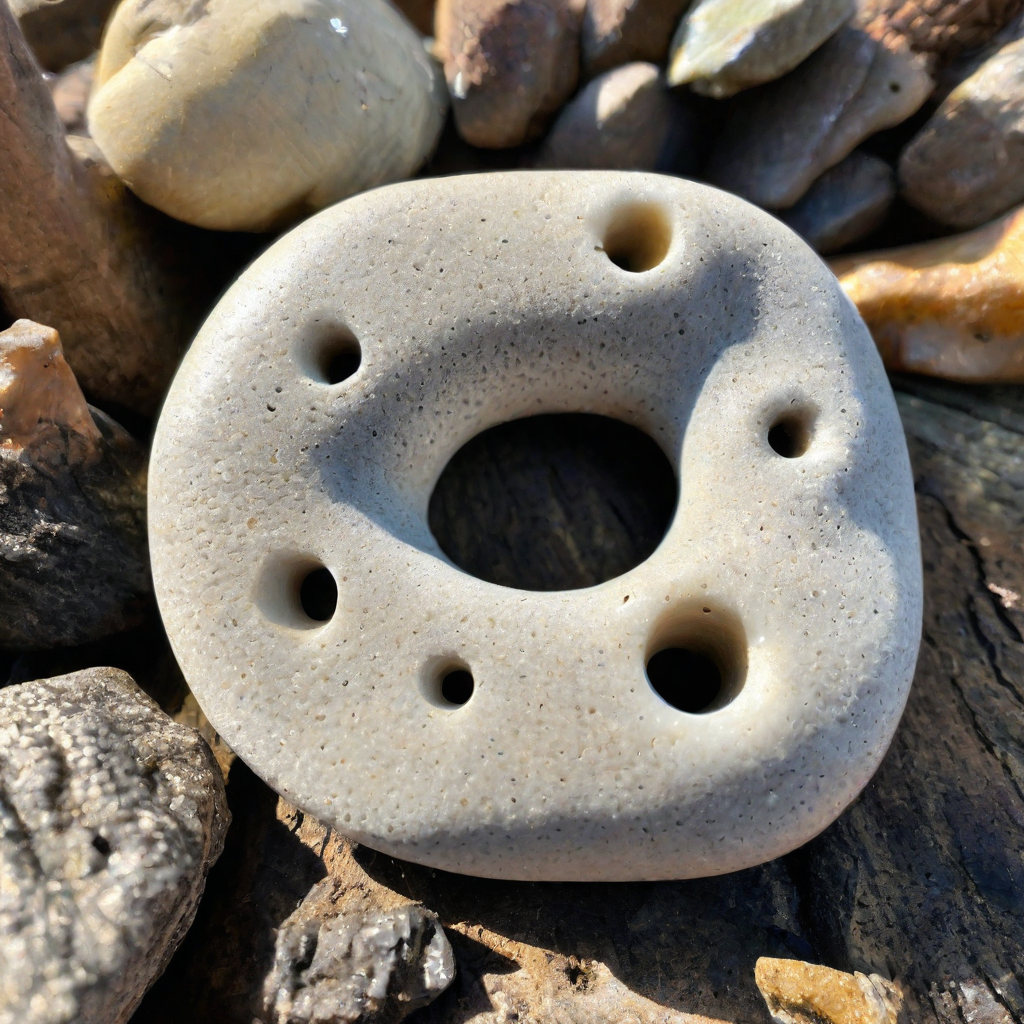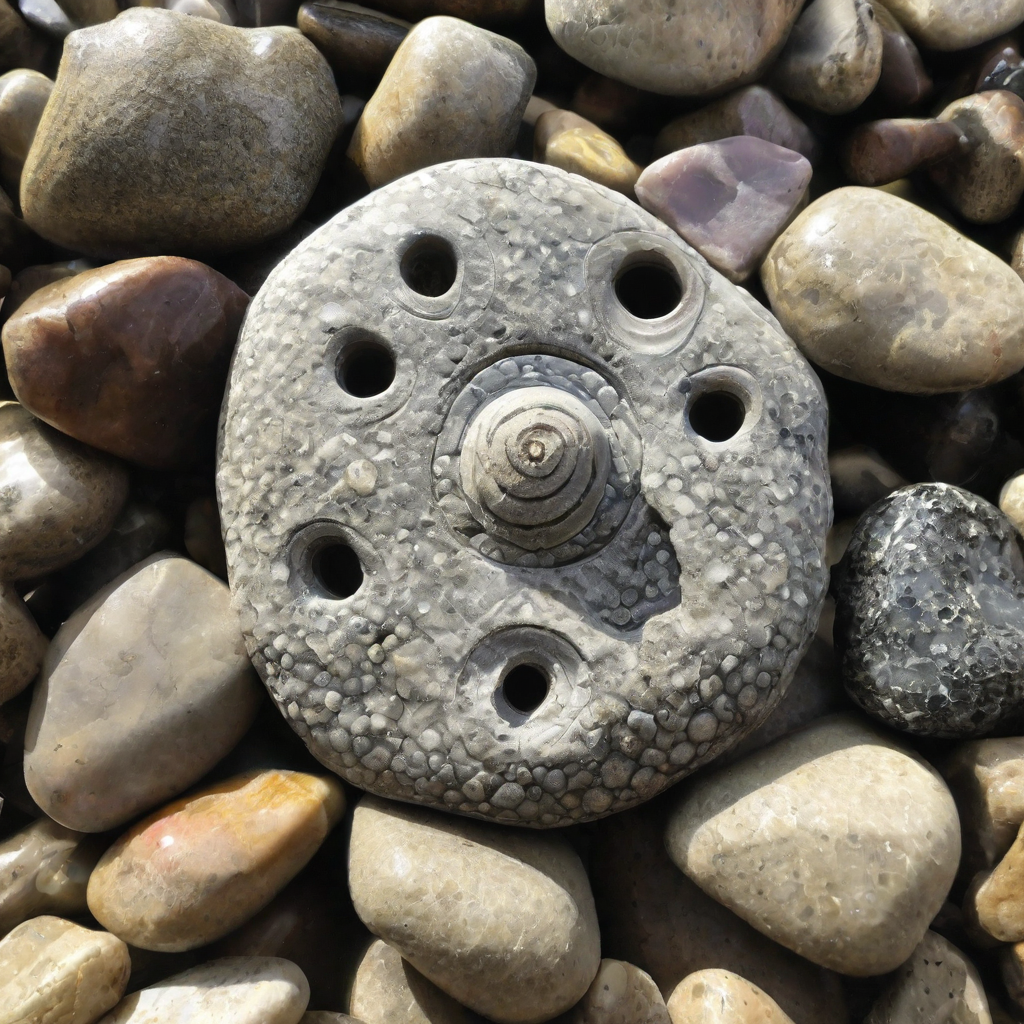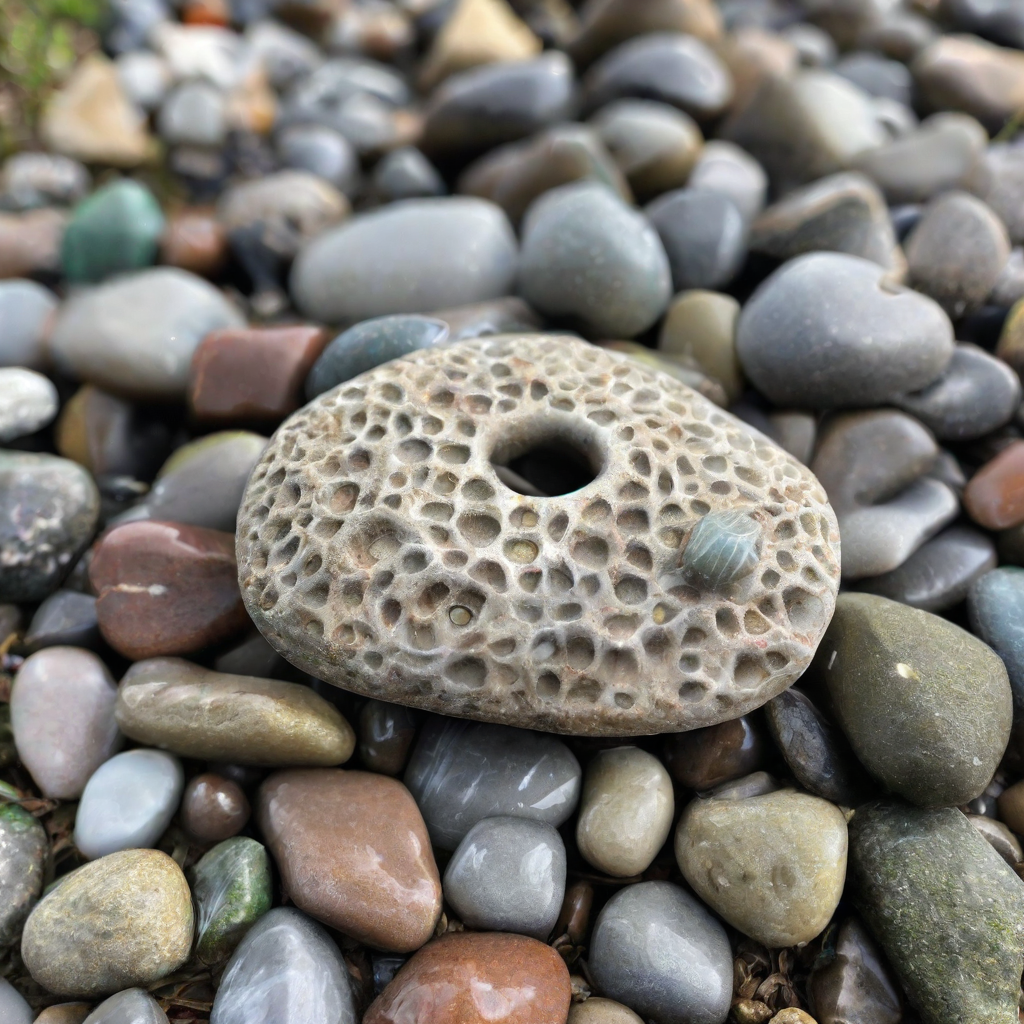Have you ever spotted a strange stone with a naturally worn hole along a riverbank and wondered what on earth it could be? What if we told you it’s a magical hag stone?
For centuries, people have believed these holey stones offer protection, healing, and even a glimpse into the spirit world!
In this post, we will unravel the secrets of hag stones.
What Is a Hag Stone?

A hag stone, also known as a witch stone, adder stone, or holey stone, is a stone with a naturally occurring hole worn through it. These round stones are usually found near bodies of water like rivers, streams, or the ocean where they have been shaped by the currents over many years.
Hag stones can range from tiny pebbles to large rocks and are very common in certain water-side locations if you know where to look.
Are Hag Stones Rare?
While any stone with a hole worn through it qualifies as a hag stone, completely round stones with symmetrical holes in their center are considered quite rare and special.
The most common hag stones are irregularly shaped with the hole located off-center, which is simply a result of how they come to form through the natural elements. So hag stones themselves are not necessarily rare, but ones with the ideal shape and hole placement are more unique finds.
How Are Hag Stones Formed?
Hag stones come about through the work of flowing water currents, wearing away at the middle of a stone over many decades or even centuries.
The hole tends to form where the stone contains a softer, weaker bit of material or a natural cavity within that gets eroded by sand and pebbles carried in rivers or the ocean.
Once a tiny opening forms, the currents going through it cause more erosion making the hole larger and rounder over time.
Sturdier materials around the outside edges of the stone keep it from simply breaking apart. The flowing water that shapes hag stones give them their alternative name of adder stones.
Where Can Hag Stones Be Found?
The best places to look for hag stones are in and around moving bodies of water, particularly areas with small, smooth rocks. Riverbeds, beaches, streams, and creek beds are all prime hag stone hunting grounds.
Any place the rocks have been tumbled and smoothed offers possibilities of nice hag stones having formed there over time.
Nearby gravel bars and banks also make good places to search when water levels are lower. Look for areas where small stones have piled up as these may conceal buried hag stones as well.

Where Do You Find Hag Stones?
Some specific places legendary for producing hag stones include Kejimkujik National Park seasides in Nova Scotia, banks of the Hessian Nidder river in Germany, beaches near Whitby and Robin Hood’s Bay in England, Lake Superior shores, and many sites across Ireland’s rocky western coasts.
Certain parts of the eastern United States also yield the stones frequently including areas of Massachusetts, Connecticut and Rhode Island. Really anywhere there are rivers, oceans or streams flowing over loose rocks for centuries offer chances of hag stones appearing.
How To Find Hag Stones
As hag stones form near water, that’s where to start when searching for them. Wait for low tide at a beach and look in areas with many small, smoothed rocks. Check piles of gravel and small stones that accumulate at bends in rivers or creeks.
Wade carefully through shallow streams and look under the water as flowing currents still hide stones underwater. Scan for the sight of a hole or crater shape visible through piles of wet pebbles. Check around bigger rocks and stone structures by bodies of water too.
Sift hands through loose rocky areas, feeling for the hole with your fingers. Prime areas produce multiple hag stones so if you find one, search thoroughly nearby for more. Patience and persistence when searching pays off when hunting the stones.
Are Hag Stones Lucky?
In various folklore and legends across the British Isles and Europe, hag stones are considered magical charms.
Supposed to have protective abilities and healing powers, they come with a whole host of mystical lore attached to them. Some believe hag stones ward off curses, spells or the evil eye. Others claim they can even enable the owner to see fairies, ghosts or other spirits when looked through the hole.
Additional powers include the ability to prevent nightmares when placed under your bed or pillow. A few legends hold that snakes are unable to pass over or through the stones.
And hanging one near your property, livestock or home is thought to bring good luck. Their multiple legendary attributes make them highly prized finds.

What Makes A Hag Stone Special?
While any stone with a worn through hole can qualify as a hag stone, certain qualities make specific ones more valuable. A round or oval shape with a symmetrically centered hole is considered the most desirable and uncommon.
The greater number and size of holes also increases their worth, as does having interesting or distinctive markings in the stone. Age comes into play as well since erosion from water makes hag stones develop over extremely long periods of time.
One with evidence of more advanced smoothing, hole shaping and stone carving from extended flowing exposure carries greater fascination.
Also, discovering one at a site legendary or locally renowned for producing special hag stones helps mark it as a premier find.
Should Hag Stones Be Kept Secret?
Some argue hag stones lose their protective abilities if the exact spot they’re found gets widely known rather than kept secret. But most agree freely sharing photos or news of locations simply spreads enjoyment of the stones to more interested hunters.
As water involvement forms the basis for the mythic properties, where the stone originated likely matters less than a finder personally connecting to that specific hag stone and its associated legends.
No universal rule says locations must be kept hidden. Just be sure to leave giant untouched stones or environmentally fragile areas protected. In general though, promoting responsible hag stone finding simply shares the wonder.
Can Hag Stones Be Shells?
While usually referring to stones, the term hag stone does also sometimes apply to certain water-worn shells. Particularly round shells with symmetrical holes caused by natural erosion can also qualify as types of hag stones.
As currents and sand smooth and penetrate shells in similar ways as stones over time, it leaves identical resulting FORM. One difference comes in origin stories with shells less often referenced in the mystical and legendary properties historically.
But holey shells clearly resemble the design and so often classify by association as hag shells or cowrie shells. Most claims of supernatural abilities still focus on stone composition but some transfer those attributes to qualifying shells too.

Can You Make Your Own Hag Stone?
While natural formation defines a true hag stone, you can also handcraft a replica. By carefully drilling holes straight through the center of flat or round stones using a rotary tool, masonry bit or high speed cutter, homemade attempts take shape.
Going slowly to avoid cracking allows cleanly cutting the hole. Use a preferred stone type with relatively solid composition that makes clean hole boring manageable. Irregular softer stones prove much harder shaping this way.
Tumble afterward if available to achieve a smooth, water-worn appearance. Manually carved and polished craft store stones also work using slow drilling to gets holes positioned just right.
These fabricated technique copies may lack a natural hag stone’s associated magic but do let you customize for desired shapes and hole sizes much easier.
How Many Holes in a Hag Stone?
The requisite design feature of any hag stone remains a single prominent hole worn all the way through its center. But the stones actually often form multiple holes in the process of natural erosion creating that defining hole. Smaller eroded spots appear across sides or intersecting the main hole.
Sometimes many secondary holes break through making quite porous displays while maintaining an obvious primary hole. More rare versions even feature added huge holes on sides as currents wear down extensions beyond the middle.
The most legendary and fantastical accounts of hag stones tend to describe those with higher numbers of sizeable holes rather than just the basic penetrating variety. But for hag stone status, strictly only an obvious solitary hole remains essential.
What Is the Hole in a Hag Stone For?
In paranormal lore, gazing through the hole in a hag stone holds particular importance regarding its mythical powers. You look through it to enable visions of spirits, fairies, or the future by various legends.
Hung over doorways, the hole also potentially captures evil intent aimed at inhabitants. Issues with witches or dark magic often reference driving them off via the hole trapping their jealous spells before hitting intended victims.
Less elaborately embellished properties like protection from nightmares and snakes might rely solely on the stone itself with no clear hole purpose beyond identifying it.
But most stories with vast supernatural themes utilize the hole specifically as key to unlocking magic. Therefore despite natural causes forming it, the hole takes on heavy mystical symbolism.
What Does a Hag Stone Look Like?
Hag stones come in so many shapes, sizes, colors and hole formations that no definitive standard occurs naturally.
Round and egg-shaped stones with a straight hole piercing edge to edge commonly appear but aren’t mandatory. Oval, flat or square chunkier stones work too.
Colors include solid reds, grays, whites, browns or mixed patterns. Commonly they feature rougher stone surfaces but also sometimes show smoothed fronts with textures surrounding holes or edges.
They measure from tiny one inch pebbles to gigantic weighty formations. Really any stone eroded straight through by natural elements potentially qualifies assuming a visible hole. Multi-holed stones are also common.
Only manmade drilling marks drastically downplay hag stone authenticity by damaging the essential primitive rawness.
Should I Return My Hag Stone If Bad Luck?
An initial instinct upon experiencing poor luck with an acquired hag stone keeps the negative association going might have you wanting to return it fast. But legendary hag stone lore suggests the opposite—that you need to retain and reconnect to the stone to reverse your direction.
Stories claim discarded hag stones tend to reappear near owners signaling unfinished business or that bad energies still haunt you. Simply keeping it nearby to reignite a protective bond without directly engaging is considered safest if truly seeming to relate to your streak of misfortune.
Let it sit dormant for a while as just an observational reminder before considering actively working with it again through methods known to traditionally set right stones that haven’t worked out positively. Patience usually sees luck change.
Conclusion
Hag stones offer fascination as both naturally occurring geological wonders and legendary artifacts steeped in mythic intrigue. The allure of discovering your own piece of history shaped by the elements over countless centuries appeals as a hunt for treasure.
Collectors value flawless specimens but even small battered stones with crude holes capture incredible timescale imagination and environmental essence.
Beyond scientific interest, the folklore and compelling tales that about special powers, magic and fortune link to the stones generates infectious passion.
Each represents a story millions of years in creation and still now, every new exposed stone signals another narrative just beginning.
A gift from the structures of the Earth itself shaped under the most fundamental forces over eras of terrain and climate shifts unrelatable in normal human time spans, hag stones bridge reality with mystery in a singular ancient relic.
About the Author
Nia Ivy is an intuitive empath, reiki healer, and certified yoga instructor. She teaches workshops on energy healing, developing intuition, and using yoga and meditation to tap into higher states of consciousness. Nia believes we all have innate healing abilities if we cultivate the self-awareness to access them. Her own spiritual awakening came through consistent mindfulness practices. She aims to hold space for others to find their inner light.




